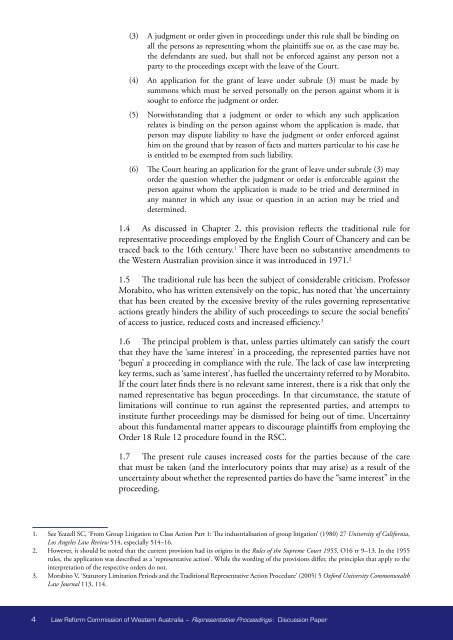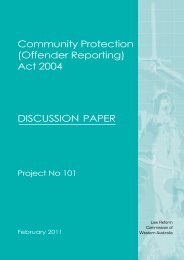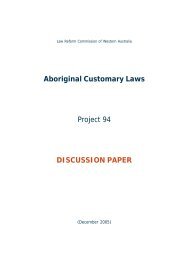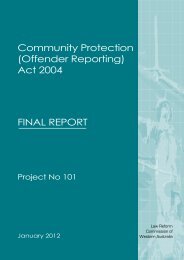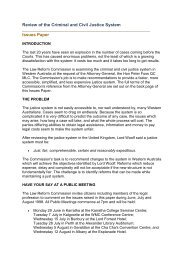Discussion Paper - Law Reform Commission of Western Australia
Discussion Paper - Law Reform Commission of Western Australia
Discussion Paper - Law Reform Commission of Western Australia
Create successful ePaper yourself
Turn your PDF publications into a flip-book with our unique Google optimized e-Paper software.
(3) A judgment or order given in proceedings under this rule shall be binding on<br />
all the persons as representing whom the plaintiffs sue or, as the case may be,<br />
the defendants are sued, but shall not be enforced against any person not a<br />
party to the proceedings except with the leave <strong>of</strong> the Court.<br />
(4) An application for the grant <strong>of</strong> leave under subrule (3) must be made by<br />
summons which must be served personally on the person against whom it is<br />
sought to enforce the judgment or order.<br />
(5) Notwithstanding that a judgment or order to which any such application<br />
relates is binding on the person against whom the application is made, that<br />
person may dispute liability to have the judgment or order enforced against<br />
him on the ground that by reason <strong>of</strong> facts and matters particular to his case he<br />
is entitled to be exempted from such liability.<br />
(6) The Court hearing an application for the grant <strong>of</strong> leave under subrule (3) may<br />
order the question whether the judgment or order is enforceable against the<br />
person against whom the application is made to be tried and determined in<br />
any manner in which any issue or question in an action may be tried and<br />
determined.<br />
1.4 As discussed in Chapter 2, this provision reflects the traditional rule for<br />
representative proceedings employed by the English Court <strong>of</strong> Chancery and can be<br />
traced back to the 16th century. 1 There have been no substantive amendments to<br />
the <strong>Western</strong> <strong>Australia</strong>n provision since it was introduced in 1971. 2<br />
1.5 The traditional rule has been the subject <strong>of</strong> considerable criticism. Pr<strong>of</strong>essor<br />
Morabito, who has written extensively on the topic, has noted that ‘the uncertainty<br />
that has been created by the excessive brevity <strong>of</strong> the rules governing representative<br />
actions greatly hinders the ability <strong>of</strong> such proceedings to secure the social benefits’<br />
<strong>of</strong> access to justice, reduced costs and increased efficiency. 3<br />
1.6 The principal problem is that, unless parties ultimately can satisfy the court<br />
that they have the ‘same interest’ in a proceeding, the represented parties have not<br />
‘begun’ a proceeding in compliance with the rule. The lack <strong>of</strong> case law interpreting<br />
key terms, such as ‘same interest’, has fuelled the uncertainty referred to by Morabito.<br />
If the court later finds there is no relevant same interest, there is a risk that only the<br />
named representative has begun proceedings. In that circumstance, the statute <strong>of</strong><br />
limitations will continue to run against the represented parties, and attempts to<br />
institute further proceedings may be dismissed for being out <strong>of</strong> time. Uncertainty<br />
about this fundamental matter appears to discourage plaintiffs from employing the<br />
Order 18 Rule 12 procedure found in the RSC.<br />
1.7 The present rule causes increased costs for the parties because <strong>of</strong> the care<br />
that must be taken (and the interlocutory points that may arise) as a result <strong>of</strong> the<br />
uncertainty about whether the represented parties do have the “same interest” in the<br />
proceeding.<br />
1. See Yeazell SC, ‘From Group Litigation to Class Action Part 1: The industrialisation <strong>of</strong> group litigation’ (1980) 27 University <strong>of</strong> California,<br />
Los Angeles <strong>Law</strong> Review 514, especially 514–16.<br />
2. However, it should be noted that the current provision had its origins in the Rules <strong>of</strong> the Supreme Court 1955, O16 rr 9 –13. In the 1955<br />
rules, the application was described as a ‘representative action’. While the wording <strong>of</strong> the provisions differ, the principles that apply to the<br />
interpretation <strong>of</strong> the respective orders do not.<br />
3. Morabito V, ‘Statutory Limitation Periods and the Traditional Representative Action Procedure’ (2005) 5 Oxford University Commonwealth<br />
<strong>Law</strong> Journal 113, 114.<br />
4 <strong>Law</strong> <strong>Reform</strong> <strong>Commission</strong> <strong>of</strong> <strong>Western</strong> <strong>Australia</strong> – Representative Proceedings : <strong>Discussion</strong> <strong>Paper</strong>


